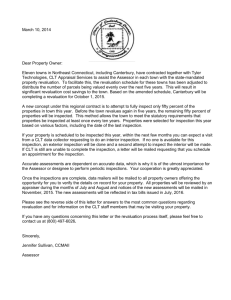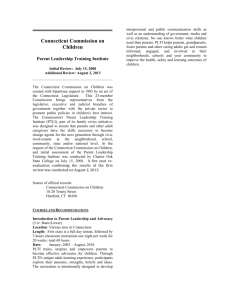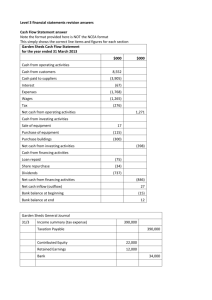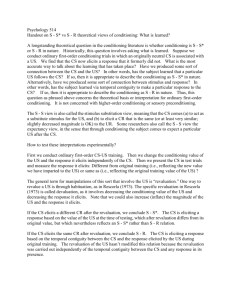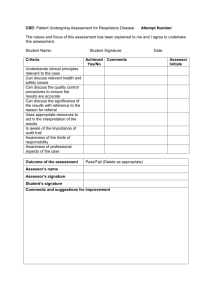Performance–Based Revaluation Testing Standards and
advertisement
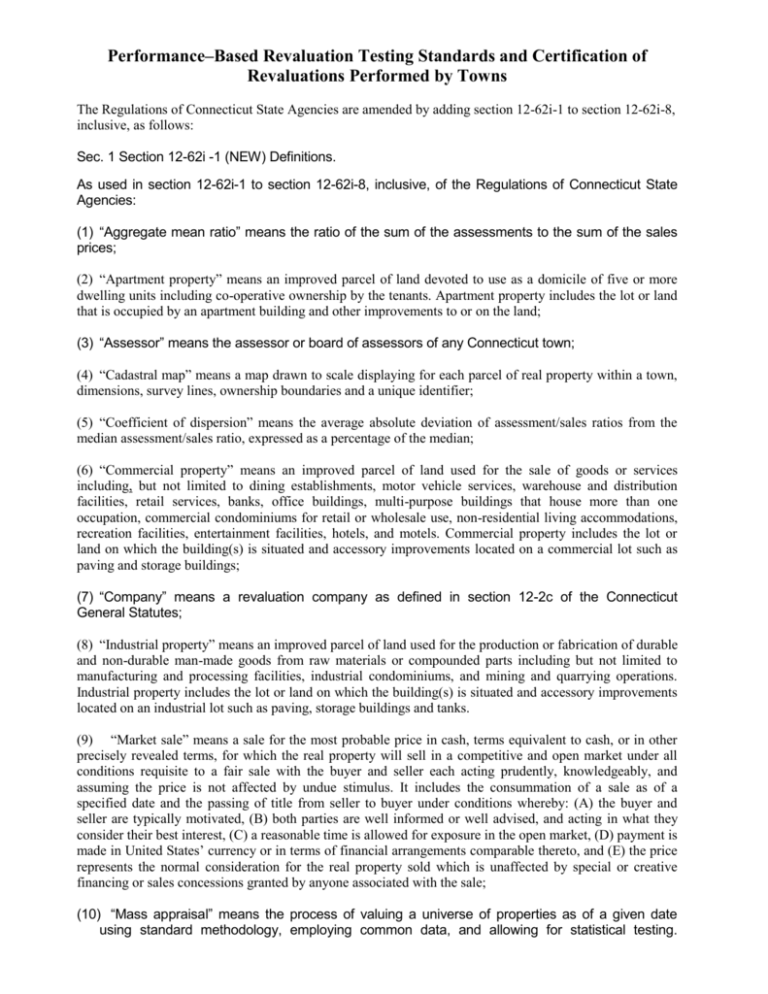
Performance–Based Revaluation Testing Standards and Certification of Revaluations Performed by Towns The Regulations of Connecticut State Agencies are amended by adding section 12-62i-1 to section 12-62i-8, inclusive, as follows: Sec. 1 Section 12-62i -1 (NEW) Definitions. As used in section 12-62i-1 to section 12-62i-8, inclusive, of the Regulations of Connecticut State Agencies: (1) “Aggregate mean ratio” means the ratio of the sum of the assessments to the sum of the sales prices; (2) “Apartment property” means an improved parcel of land devoted to use as a domicile of five or more dwelling units including co-operative ownership by the tenants. Apartment property includes the lot or land that is occupied by an apartment building and other improvements to or on the land; (3) “Assessor” means the assessor or board of assessors of any Connecticut town; (4) “Cadastral map” means a map drawn to scale displaying for each parcel of real property within a town, dimensions, survey lines, ownership boundaries and a unique identifier; (5) “Coefficient of dispersion” means the average absolute deviation of assessment/sales ratios from the median assessment/sales ratio, expressed as a percentage of the median; (6) “Commercial property” means an improved parcel of land used for the sale of goods or services including, but not limited to dining establishments, motor vehicle services, warehouse and distribution facilities, retail services, banks, office buildings, multi-purpose buildings that house more than one occupation, commercial condominiums for retail or wholesale use, non-residential living accommodations, recreation facilities, entertainment facilities, hotels, and motels. Commercial property includes the lot or land on which the building(s) is situated and accessory improvements located on a commercial lot such as paving and storage buildings; (7) “Company” means a revaluation company as defined in section 12-2c of the Connecticut General Statutes; (8) “Industrial property” means an improved parcel of land used for the production or fabrication of durable and non-durable man-made goods from raw materials or compounded parts including but not limited to manufacturing and processing facilities, industrial condominiums, and mining and quarrying operations. Industrial property includes the lot or land on which the building(s) is situated and accessory improvements located on an industrial lot such as paving, storage buildings and tanks. (9) “Market sale” means a sale for the most probable price in cash, terms equivalent to cash, or in other precisely revealed terms, for which the real property will sell in a competitive and open market under all conditions requisite to a fair sale with the buyer and seller each acting prudently, knowledgeably, and assuming the price is not affected by undue stimulus. It includes the consummation of a sale as of a specified date and the passing of title from seller to buyer under conditions whereby: (A) the buyer and seller are typically motivated, (B) both parties are well informed or well advised, and acting in what they consider their best interest, (C) a reasonable time is allowed for exposure in the open market, (D) payment is made in United States’ currency or in terms of financial arrangements comparable thereto, and (E) the price represents the normal consideration for the real property sold which is unaffected by special or creative financing or sales concessions granted by anyone associated with the sale; (10) “Mass appraisal” means the process of valuing a universe of properties as of a given date using standard methodology, employing common data, and allowing for statistical testing. Methodology that is acceptable shall include, but is not limited to, automated valuation models, adaptive estimation procedure, multiple regression analysis, statistical analysis and other generally accepted techniques; (11) “Mean ratio” means the arithmetic average of the ratios; (12) “Median ratio” means the value of the middle ratio in an uneven number of ratios arranged or arrayed according to size or the arithmetic average of the two central ratios in an even number of ratios similarly arranged; (13) “Neighborhood” means a geographic area of complementary real property parcels that share similar locational and market value characteristics, and may be defined by natural, man-made, or political boundaries; (14) “Price related differential” means the ratio of the mean ratio to the aggregate mean; (15) “Property class” means any one of the following three major classifications of real property: (A) residential; (B) commercial including apartments, industrial and public utility; and (C) vacant land; (16) “Public utility” means an improved parcel of land used to provide services to the general public that are typically provided by a public service company as defined in section 16-1 of the Connecticut General Statutes. Public utility property includes the lot or land on which the building(s) is situated and accessory improvements located on the public utility lot such as paving, storage buildings and tanks; (17) “Ratio” means the property’s assessed valuation divided by the property’s sales price; (18) “Residential property” means an improved parcel of land devoted to human habitation for use as a domicile of less than five dwelling units. Property used for human habitation includes but is not limited to year round residences, rural residences, condominiums, estates, seasonal residences, and individually owned mobile manufactured homes. Residential property includes the lot or land on which the dwelling is situated, and accessory buildings(s) located on the parcel such as garages, sheds, pools and tennis courts; (19) “Revaluation” means the mass appraisal of property to determine the true and actual value of all real property in a town for assessment purposes in accordance with section 12-62 of the Connecticut General Statutes; (20) “Sales time period” means the twelve-month period beginning twelve months before the assessment date which is the effective date of a revaluation, provided if the total number of market sales occurring in said period is less than thirty the time period prior to said assessment date shall be extended in three-month increments until the number of market sales having taken place is equal to or greater than thirty, but shall not be extended more than thirty months prior to said assessment date; (21) “Secretary” means the Secretary of the Office of Policy and Management, or his designee; (22) “Sold” means properties that were transferred during the sales time period, provided such transfers were market sales; (23) “Unsold” means properties that were not transferred during the sales time period or were not market sales; (24) “Unsold property test” means the ratio of (A) the ratio of the market value of sold properties, to (B) the ratio of the market value of unsold properties where the ratio of the market value of sold properties is the total market value of all sold properties after revaluation to the total market value of all sold properties before revaluation, and the ratio of the market value of unsold properties is the total market value of all unsold properties after revaluation to the total market value of all unsold properties before revaluation; (25) “Vacant Land” means land that is not developed or land lacking in essential appurtenant improvements above and below water, that are required in order for the land to serve a useful purpose. It is land that may be an approved subdivision but is not presently being physically improved or sold as lots. Sec. 2. Section 12-62i -2 (NEW) General Provisions Performance-based revaluation standards shall consist of two acceptable methods as set forth in section 1262i-3 and 12-62i-4 of the Regulations of Connecticut State Agencies. The assessor shall utilize one of the methods so described. Sec. 3. Section 12-62i -3 (NEW) Ratio Testing Standards (a) Compiling Market Value Data (1) A file of all real property sales transactions for the sales time period used shall be established. For each such transaction the following information shall be included in the file: parcel identification number, property location, United States Census Bureau census tract number, date of sale, sales price, property assessment as of the date of the sale, property class, and any other salient property characteristics as of the date of the sale. The sales price of the property and its condition as of the date of the sale should be verified, if possible, with the buyer or seller. (2) If the sale property is not considered a market sale as delineated in subdivision (9) of section 12-62i-1 of the Regulations of Connecticut State Agencies, the file shall contain the reason for such determination. (3) The file may reflect an adjustment to the property sales price. The reason(s) for the adjustment shall be documented. Reasons for such an adjustment may include, but are not be limited to: (A) The fact that personal property is included in the transaction; (B) The existence of a lease that does not represent market rent, as defined in section 12-63b of the Connecticut General Statutes; and (C) The effects of price changes reflected in the real estate market between the date of sale and the assessment date that is the effective date of a revaluation. (b) Prior to finalizing a revaluation, the assessor shall conduct the following tests regarding the assessments derived from such revaluation. The assessments resulting from the revaluation shall be deemed sufficient, provided the following criteria are met: (1) the overall level of assessment for all property classes shall be within plus or minus ten percent of the required seventy percent assessment ratio, as measured by the overall median ratio, and (2) the level of assessment for each property class with fifteen or more market sales shall be within plus or minus five percent of the median overall level of assessment for each property class, and (3) the coefficient of dispersion for each property class with fifteen or more market sales shall be equal to or less than fifteen percent for all property, equal to or less than fifteen percent for residential property , equal to or less than twenty percent for commercial property , and equal to or less than twenty percent for vacant land, and (4) the price related differential for all properties and for each property class for which there are fifteen or more market sales shall be within 0.98 and 1.03, and (5) the unsold property test result shall be between 0.95 and 1.05. (c) In the event that the criteria described in subdivision (1), (2), (3), (4) or (5) of subsection (b) of this section are not met, the assessor shall, prior to the implementation of the revaluation, further analyze and refine the data elements or methods used in the revaluation. The assessor shall revalue the parcels of real property for which a deficiency in either the level of assessment or the uniformity of assessments has been identified. Sec. 4. Section 12-62i -4 (NEW) Procedural Testing Standards (a) Prior to finalizing a revaluation, the assessor and the company, if any, employed by the town, shall conduct the following procedures during the revaluation program: (1) Management A written revaluation project plan shall be developed prior to the commencement of the revaluation and updated as necessary during the course thereof. The project plan shall include, but is not limited to, a list of project activities, person(s) responsible for each activity and the time frame of each activity. Periodic reports on the progress of the revaluation project plan shall be completed by the assessor and shall be filed in the assessor’s office. Each such report shall chronicle the work completed and the work remaining for each activity. (2) Property Inventory (A) The cadastral maps shall be up to date. (B) Each real estate parcel shall have a property record file, which should be computerized. Each property record file shall contain the following data, as applicable: (i) parcel size (ii) current land use (iii) zoning classification of parcel (iv) site characteristics that contribute to the value of the land (v) neighborhood code (vi) building size (vii) construction quality or grade classification (vii) year built (ix) condition of the building(s) (x) significant building characteristics, such as number of stories, height, construction type, and wall type (xi) other characteristics that contribute to the value of the building (xii) other structures or improvements that may exist on the parcel, such as a swimming pool, fencing, garage, or shed. (C) Each land or building characteristic having a qualitative attribute shall have an alphanumeric code. (D) A property inspection system shall be maintained. (E) A building permit monitoring system shall be maintained. (F) A quality assurance program consisting of: (i) a data collection manual that explains how to measure structures and how to select the most appropriate property characteristics of those available; (ii) a data review program to ensure all essential property characteristics are entered into the property record file; (iii) an audit trail for either manual systems or computer systems that tracks changes in property records, who made the change, when the change was made and the value previous to each change. (3) Compiling Market Value Data (A) A file of all real property sales transactions for the sales time period used shall be established. For each such transaction the following information shall be included in the file: parcel identification number, property location, United State Census Bureau census tract number, date of sale, sales price, property assessment as of the date of the sale, property class, and any other salient property characteristics as of the date of the sale. The sales price of the property and its condition as of the date of the sale should be verified, if possible, with the buyer or seller. (B) If the sale property is not considered a market sale as delineated in subdivision (9) of section 12-62i-1 of the Regulations of Connecticut State Agencies, the file shall contain the reason for such determination. (C) The file may reflect an adjustment to the property sales price. The reason(s) for the adjustment shall be documented. Reason(s) for such an adjustment shall include, but are not be limited to: (i) (ii) The fact that personal property is included in the transaction; The existence of a lease that does not represent market rent, as defined in section 12-63b of the Connecticut General Statutes; and (iii) The effects of price changes reflected in the real estate market between the date of sale and the assessment date that is the effective date of a revaluation. (D) A file of income and expense statements submitted in accordance with section 12-63c of the Connecticut General Statutes for the two-year period prior to the assessment date that is the effective date of a revaluation shall be maintained. (E) If the cost approach to valuation is utilized for the revaluation, all building cost schedules, which shall reflect local construction costs as of the effective date of the revaluation, shall be maintained in the assessor’s office. (F) Market Analysis and Valuation (i) All parcels shall be stratified according to property class and neighborhood. (ii) Market sales analysis for market value trends and price level changes during the sales time period shall be conducted. (iii) If the cost approach method of valuation is utilized, market sales data should be used to develop schedules of depreciation. (iv) Criteria for the identification of comparable properties shall be established, documented and used. (v) For each parcel of property, more than one acceptable appraisal methodology should be used, if possible, to determine its market value. For each vacant land parcel, the direct sales comparison appraisal methodology should be used for revaluation purposes. (vi) Neighborhoods should be delineated on maps that display unit values for land valuation or are indexed to land value tables. (vii) For each residential property, the direct sales comparison appraisal methodology should be used for revaluation purposes. The cost approach may be used if, in the judgement of the assessor, insufficient comparable market sales data exist for valuation purposes. (viii) For each commercial or special use property, the income and/or direct sales comparison appraisal methodology should be used for valuation purposes. The cost approach may be used if, in the judgement of the assessor, insufficient comparable market sales or income data exist for revaluation purposes. (b) A review of all real property values derived from the revaluation program shall be conducted. The process by which the review was conducted shall be put in writing and all changes in valuations effected during the review shall be documented. (c) Documentation of the methodology used in the revaluation process shall be in writing and available for public inspection. (d) Any departure from the requirements set forth in subsections (a) to (c) of this section shall be reasonable and the reasons shall be documented in writing and available for public inspection. Sec. 5. Section 12-62i -5 (NEW) Certification (a) On a form prescribed by the Secretary, the assessor shall certify that all real property located within the town has been revalued and that the revaluation meets the performance-based revaluation standards of subsections (b) or (c) of section 12-62i-2 of the Regulations of Connecticut State Agencies. Said form shall be signed and filed in the office of the assessor on or before the date the grand list that reflects real property assessments based on the revaluation is signed and filed pursuant to section 12-55 of the Connecticut General Statutes. A copy of said form shall also be submitted to the town clerk, who shall record such form on the land records, and to the chief executive officer of the town and the Secretary, within ten days of the date it is signed by the assessor. (b) If the revaluation was conducted in whole or in part by one or more companies, as defined in subdivision (7) of section 12-62i-1 of the Regulations of Connecticut State Agencies, the form shall be co-signed by a person employed by each such company who is certified by the Secretary as a revaluation company supervisor in accordance with subsection (d) of section 122b-6 of the Regulations of Connecticut State Agencies. Sec. 6. Section 12-62i -6 (NEW) Administration of Penalty (a) If the Secretary determines that a town has failed to comply with the provisions of sections 12-62i-3 or 12-62i-4 of the Regulations of Connecticut State Agencies, as the case may be, the Secretary shall send written notification to the town’s chief executive officer by May first that the town is subject to the penalty pursuant to section 12-62i of the General Statutes. The Secretary shall cause the certification made to the State Comptroller for each applicable grant-in-aid to the town during such fiscal year, to reflect the amount of reduction in such grant-in-aid. (b) If a town has failed to comply and is not eligible to receive any such state grants-in-aid, the Secretary shall send a written demand to the chief executive officer of the town for the immediate payment to the State Treasurer of an amount equal to three per cent of the town’s property tax levy for the fiscal year immediately preceding. Such payment shall be required to be made within ninety days of the date said demand is received. Sec. 7. Section 12-62i -7 (NEW) Appeals The chief executive officer of any town that is aggrieved by the action of the secretary in issuing notification of the imposition of a penalty in accordance with section 12-62i-6 of the Regulations of Connecticut State Agencies, may appeal to the secretary within thirty days of such notice. Such appeal shall be in writing and shall contain a reason for the appeal. Such appeal will be considered a contested case in accordance with chapter 54 of the Connecticut General Statutes. Sec. 8. Section 12-62i -8 (NEW) Effective Date Sections 12-62i-1 to 12-62i-7 of the Regulations of Connecticut State Agencies are effective with respect to a revaluation implemented on or after October 1, 2002. STATEMENT OF PURPOSE: The proposed regulations will set forth standards for the certification of periodic revaluations of real property by towns. Each town will be required to certify that assessments derived from its revaluation meet certain statistical tests or that certain procedures were performed in conjunction with the revaluation. The proposed regulations also set forth the procedure that a town's assessor will use to certify that a revaluation meets the appropriate standards and the administration of the statutory penalty and appeal of such penalty if a town fails to comply with the provisions of these proposed regulations.
